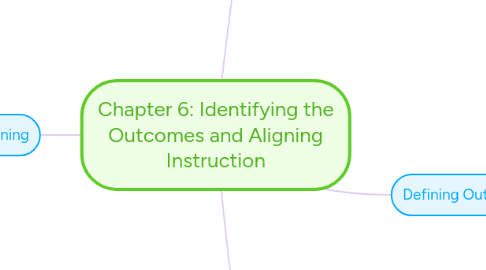
1. Learning outcomes
1.1. identified goals
1.2. KASIs
1.3. communicate what the learner should know, feel or be able to do
1.4. written from the viewpoint of the learner
2. Defining Outcomes
2.1. Define the type of outcomes to be identified and the level of detail to be assessed
2.1.1. Behavioral objectives
2.1.1.1. emphasize performance and competencies
2.1.2. Cognitivist learning objectives
2.1.2.1. focus on the way knowledge is acquired, encoded and retrieved
2.1.3. Instructivist learning objectives
2.1.3.1. Presents clear goals and mastery-based objectives at the beginning of instruction
2.1.3.2. Addresses discrete "chunks" of learning, incrementally assesses each "chunk"
2.1.3.3. Elaborates on the relevance of the outcomes to the learners and makes a distinction between "need to know" and "nice to know"
2.1.3.4. SMART: Specific, Measurable, Action-oriented, Realistic, Timely
2.1.4. Learning objectives should include:
2.1.4.1. Audience, Behavior, Conditions, and Degree (ABCD)
2.1.5. **Specific learning objectives can improve intentional learning, but may decrease incidental learning**
2.2. Write outcomes that communicate the desired behavior, conditions, and standards
2.2.1. Use action verbs
2.2.2. outcomes can be confused with learning activities
2.2.3. Bloom's Taxonomy - can be helpful to write outcomes that effectively communicate to learners/stakeholders
2.2.3.1. progresses from lower-order thinking skills (LOTS) to higher-order thinking skills (HOTS)
2.2.3.2. remember, understand, apply in order to analyze, evaluate, create
2.3. Align outcomes to assessments and strategies
2.3.1. begin with the end in mind
2.3.2. outcomes and assessments should sound similar
2.3.3. Tell them what they need to know and do, instruct them on what they need to know and do, and test them on what they need to know and do
2.4. Plan how to convey the outcomes and communicate their relevance to learners
2.4.1. Illustrate how concepts and skills relate to outcomes
2.4.2. Connect new material to past experiences
2.4.3. Guide learner on how to customize experience to help with self-motivation
2.4.4. present outcome at the beginning and then give opportunities for self-assessments and checks throughout instruction on outcomes
2.4.5. Learning outcomes should be reviewed and approved by stakeholders
3. Destinations
4. Streamlining
4.1. Sustainable: if revising or updated materials, do the same to outcomes
4.2. Optimized: make a single table of aligned outcomes, assessments, and teaching/learning strategies
4.3. Right-Sized: Learners don't need to know all, detailed outcomes, limit 3 to 5
4.4. Continuous Improvement: check outcomes early in design process for relevance
4.4.1. Does each outcome clearly state an observable behavior, the conditions or givens to be provided, and the degree of mastery targeted?
4.4.2. Does the language of each outcome reflect the identified pedagogical approach?
4.4.3. Is each outcome reasonable given the scope of the content, the learners, and the time available?

